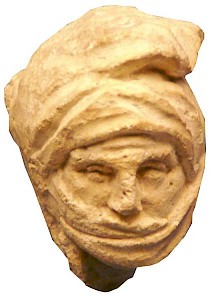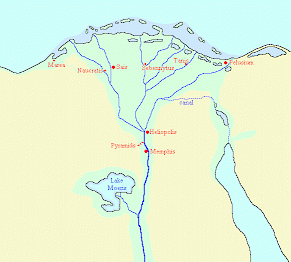Pharnabazus (2)
Pharnabazus II (c.435? - after 373 BCE): Persian nobleman, member of the Pharnacid dynasty, between 413 and 387 satrap of Hellespontine Phrygia.

Pharnabazus was the son of a Persian nobleman named Pharnaces II, who was satrap of Hellespontine Phrygia, i.e., the northwest of what is now Turkey. The family belonged to the highest Persian elite: its founder was another Pharnaces, who had been mayor of the palace of his nephew, king Darius I the Great. The descendants of this Pharnaces remained closely related to the great king: for example, the Pharnabazus who is the subject of this article married to a daughter of king Artaxerxes II Mnemon (below).
Pharnabazus II succeeded his father before the winter of 413/412. We can hardly be more precise. His father was still in office in 422, and that is all we know. But whatever the precise moment of Pharnabazus' accession to the satrapal throne, it is certain that in 413/412, he was involved in negotiations between Persia and the Greek town Sparta.
A few years before, Sparta had suffered a humiliating defeat in a war against Athens that had lasted ten years (431-421). After their victory, the Athenians had tried to conquer Sicily and had supported Amorges, the son of Pissuthnes, a rebel satrap. But this was a big mistake: the Persian king, who had respected the autonomy of the Greek towns in Asia that had been guaranteed by Athens, now decided to intervene in the Greek affairs against the Athenians. Therefore, king Darius II Nothus ordered Pharnabazus and the satrap of Lydia and Caria, Tissaphernes, to start negotiations with Sparta.
Although Pharnabazus and Tissaphernes served the same king, they were each other's rivals. They both sent ambassadors to Sparta (413/412), because the man who concluded the treaty would be the king's favorite. In this contest, Tissaphernes was victorious: he offered Sparta the support of the Persian-Phoenician navy, after which the Spartans concluded a treaty, and attacked Athens again.
However, Tissaphernes never sent the navy, and the Spartans now decided to negotiate with Pharnabazus. These negotiations, however, were very difficult because the Athenians were still all-powerful in the Aegean sea, and the two partners were unable to reach each other.
The new negotiations caused tensions between the two rivals, and king Darius intervened: he sent his son Cyrus, who had to supervise the Persian involvement in the Greek war. Tissaphernes lost Lydia, but remained satrap of Caria. From now on, Persia supported Sparta with money and in 405, the Spartan admiral Lysander defeated the Athenian navy. In 404, Athens was forced to surrender. At the same time, Pharnabazus, Cyrus, and Tissaphernes occupied the Greek towns in Asia. The Persians benefitted most of the Spartan victory.
At the same time, king Darius died, and his son Artaxerxes II Mnemon became king. However, Cyrus decided to revolt. He was supported by 14,000 Greek mercenaries. Almost immediately, Tissaphernes sided with Artaxerxes. Pharnabazus was not really involved in the civil war, but still had to cope with some problems. After the defeat of Cyrus at Cunaxa in Babylonia in 401, the surviving mercenaries fought themselves a way back through Armenia and Paphlagonia, and in 400, they reached the satrapy of Pharnabazus, who had to pull out all the stops to prevent the looting of his dominions. But in the end, he was successful, and the mercenaries returned to the Aegean sea.
In the meantime, Tissaphernes returned to Lydia, where he had to prepare everything to withstand the Spartans, who invaded Asia (using the mercenaries mentioned above). They wanted to "liberate" the Greek towns, which in fact meant that they were building an empire of themselves. If, at this moment, the Spartan general Thibron had singled out Tissaphernes, he would have been successful, because Lydia was still unquiet. But the Spartans attacked Hellespontine Phrygia, where Pharnabazus was prepared to fight.
Next year, Thibron was replaced by Dercyllidas, who moved his army to the south and invaded Tissaphernes' territories. In Caria, the Spartan soldiers could have joined the Spartan navy, and together they could have expelled the Persian navy from the Aegean. However, Pharnabazus and Tissaphernes overcame their differences, united their forces and lured the Spartans back to the north. Shortly before the two armies joined battle, an armistice was concluded near Magnesia (397).
The two enemies concluded an armistice: Sparta would evacuate Asia, and Persia would recognize the independence of the Greek towns in Ionia - a return to the situation before 404. However, during the negotiations, the Persians continued to build a large navy in Phoenicia. It is not known why, although it is possible that Tissaphernes was again insincere and wanted to invade the Aegean with this navy. Another explanation is that it wa meant to attack Egypt, a satrapy that had recently become independent. But whatever the reason for the building of the navy, the Spartan authorities concluded that the Persian peace offer was not seriously meant, and the Spartan king Agesilaus invaded Asia with fresh troops (396).
He first sailed to Ephesus, where he concluded a truce with Tissaphernes. This may come as a surprise, but Agesilaus wanted to have a free hand to attack Pharnabazus, and Tissaphernes was waiting for reinforcements. The king expected to defeat the satraps one by one, Tissaphernes hoped that Agesilaus would defeat Pharnabazus, and that he could defeat Agesilaus. That would leave him alone as sole ruler of Asia Minor.
His machiavellistic scheme almost worked. Pharnabazus was in a very difficult position - left to his own by his colleague. But he managed to ward off the Spartans. At the same time, he sent a Rhodian named Timocrates to Greece to encourage anti-Spartan feelings.
Meanwhile, Agesilaus recruited extra soldiers among the Ionian Greeks, and in the spring, he defeated Tissaphernes in the neighborhood of Sardes. His victory was complete. Tissaphernes survived the battle, but not for long. When king Artaxerxes learned that Tissaphernes had directed the war against Pharnabazus, he sent one Tithraustes to replace him. The satrap of Lydia and Caria was executed.
Howver, when Tithraustes understood the situation, he decided to continue the diplomacy of Tissaphernes. He paid a large amount of money to Agesilaus, under the condition that he returned to the north and attacked Pharnabazus. If this plan had been executed, the satrap of Hellespontine Phrygia would have found himself in a very difficult position. But Agesilaus unexpectedly moved to the south, passed through the Ionian towns, and attacked Caria, which was still unsettled after the transition from Tissaphernes to Tithraustes.
Agesilaus wanted to continue to the east, to Cilicia, and bring the war to the east. The Spartan army marched to the interior of Asia Minor along the Royal road. However, its progress was slow because Agesilaus was unable to capture the cities along the road. This gave Pharnabazus an opportunity to build a new army, a new navy, and -even worse to the Spartan case- to find a capable admiral: the Athenian Conon.
Now, Pharnabazus could harvest what he had sown. The mission of Timocrates of Rhodes (above) had been successful: the Greeks were revolting against the Spartans, war had broken out (395). Agesilaus was recalled (394), and Pharnabazus, who no longer had an enemy to fear in Asia, joined Conon, and conquered the islands of Melos and Cythera (393).
The Corinthian War lasted until 387/386, when a peace treaty was signed between the Greeks and the Persians, which made Sparta the most powerful state in Greece, and gave Persia the Greek towns in Asia. At first, the Persians respected the autonomy of these cities, but Pharnabazus was given a new function and his successor, his son Ariobarzanes, was less respectful.

Pharnabazus, who had been one of the architects of the conquest of the Ionian cities, was rewarded by his king: he married a princess named Apame. (She was the mother of Pharnabazus' younger son Artabazus II.) He also received a very honorable new occupation: together with Tithraustes, he had to command an army that was to conquer Egypt, a former Persian possession that had been independent for some twenty years. The two attacks (in 385 and 383) were unsuccessful, partly because the pharaoh of Egypt, Achoris, used Greek mercenaries, commanded by the experienced Athenian commander Chabrias.
In 373, Pharnabazus was sole commander of a similar attack. This time, Egypt was left without allies, because Chabrias had been recalled. Pharnabazus gathered a large navy at Acre in southern Phoenicia and reinforced his army with Greek mercenaries, commanded by Iphicrates.
Their advance to Egypt was uneventful, which suggests that pharaoh Nectanebo I did not possess a navy that could attack the Persians during their five days' march through the desert between Gaza and Pelusium (i.e., Port Said). However, Pelusium was strongly defended, and the Persians were unable to capture the Egyptian stronghold. Therefore, Pharnabazus decided to go around it and used another branch of the Nile to enter the country. (The fortress that guarded the entrance was razed to the ground.) The soldiers marched on Memphis - or wanted to do so - but by that time, Iphicrates and Pharnabazus had disagreed as to strategy, and they hesitated to attack the Egyptian capital. Nectanebo was able to reinforce Memphis, and in July 373, his enemies were forced to retreat: because of the Nile inundation, the Delta had become one great swamp. Pharnabazus had underestimated the Egyptian strength and the logistics of the campaign.
It is unknown what became of Pharnabazus, who must have been at least sixty years old.